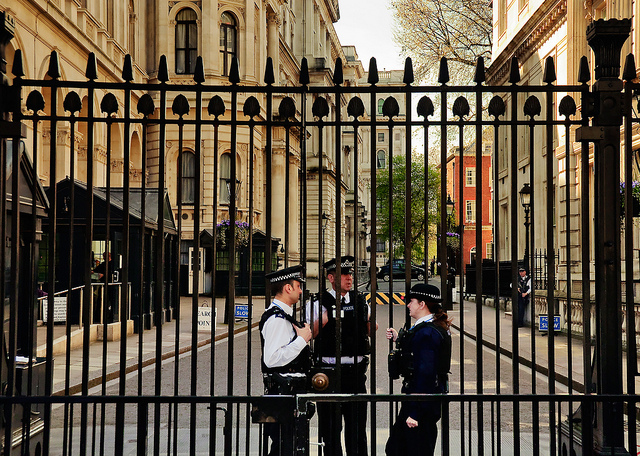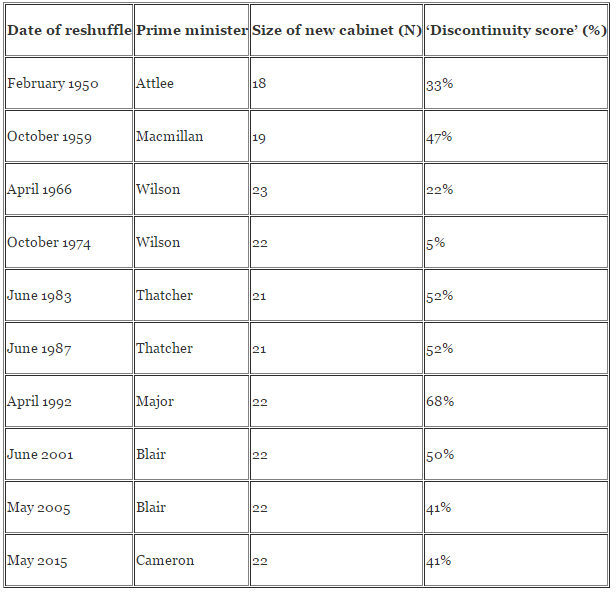Cameron’s post-election reshuffle: a historical perspective
Following his return to Downing Street at the head of a majority Conservative government, Cameron had no choice but to conduct another wide-ranging cabinet reshuffle. Elections represent obvious punctuations in government, and post-election reshuffles are a chance to inject fresh blood and new energy into Whitehall. In this article, Nicholas Allen looks at reshuffles from a historical perspective.

Credit: Kiril Strax, CC BY NC SA 2.0
The rate of ministerial turnover in Britain is often criticised for being too high. One year after he became prime minister, David Cameron was quoted as being opposed to frequent government reshuffles:
“I’m not a great believer in endlessly moving people between different jobs…. We had 12 energy ministers in nine years [under Labour]. And the tourism minister changed more often than people got off planes at Heathrow. It was hopeless. I think you’ve got to try to appoint good people and keep them.”
In the event, Cameron presided over a number of reshuffles over the course of his first term in office, including no fewer than eight cabinet reshuffles—defined here as any change in the composition of the cabinet (this excludes changes among ministers who merely ‘attend cabinet’). Of these cabinet-levelreshuffles, four were forced upon him and followed the scandal-induced resignations of David Laws, Liam Fox, Chris Huhne and Maria Miller respectively, and another was precipitated by Lord Strathclyde’s decision to leave frontline politics for personal reasons. Yet another reshuffle affected just the office of Scottish Secretary when Alistair Carmichael replaced Michael Moore. Two sets of moves involved wide-ranging discretionary changes across a number of cabinet posts, the kind of ritualised media event that the term ‘reshuffle’ usually connotes.
Following his return to Downing Street at the head of a majority Conservative government, Cameron had no choice but to conduct another wide-ranging reshuffle. Five of the seats in the pre-election cabinet and over a dozen junior government posts were held by Liberal Democrats, and all needed replacing.Meanwhile, an empty seat at the cabinet table was created by the voluntary resignation of William Hague.
Even if he had not been compelled to make so many changes, Cameron was always likely to make some.Elections represent obvious punctuations in government, and post-election reshuffles are a chance to inject fresh blood and new energy into Whitehall. Thus in 1966 Harold Wilson took the opportunity, in his own words, ‘to bring in some of our brighter and young MPs’. Meanwhile, election-winning prime ministers also possess enhanced authority and may feel emboldened to reward loyal supporters and move dissenters. Thus Margaret Thatcher in 1983 sacked several ‘Wets’ from her cabinet, notably Francis Pym, ‘whose sense of direction’, at least from her point of view, ‘had on several occasions proved faulty’.Among post-war prime ministers, only Anthony Eden declined the opportunity to reshuffle his senior teamimmediately after winning re-election in May 1955.
The following table lists all post-election cabinet reshuffles conducted by re-elected prime ministers since 1945. It also reports the size of each newly constituted cabinet, together with a simple measure of turnover in its composition, the ‘discontinuity score’. This score, reported as a percentage, reflects the proportion of members of the new cabinet who had been full members of the cabinet before the election and who had held essentially the same portfolio. A high score means more changes and less continuity; a low score means fewer changes and greater continuity
Table 1: Post-election cabinet reshuffles by re-elected prime ministers, 1945-2015
As the table shows, the scale of cabinet-level turnover has varied considerably. John Major, taking advantage of his new-found authority to fashion a government more to his tastes, made 15 changes to his cabinet of 22, giving the 1992 post-election reshuffle a discontinuity score of 68 per cent. Harold Macmillan in 1959, Margaret Thatcher in 1983 and 1987, and Tony Blair in 2001 and 2005, also conducted extensive post-election cabinet reshuffles. At the other end of the spectrum, Harold Wilson presided over the least disruptive set of changes. The one alteration he made in October 1974 was to promote John Silkin to the cabinet as Minister of State for Local Government and Planning. Silkin hadpreviously held the same post but outside of the cabinet.
In terms of numbers, how does Cameron’s latest reshuffle compare with similar post-election changes? If we again disregard changes among ministers who merely ‘attend cabinet’ (and it is interesting to note that the practice of appointing large numbers of such ministers has outlasted the demands of coalition-era intra-party management), 13 of the 22 full cabinet members in Cameron’s new government had the same status and held essentially the same portfolio before the election. The consequent discontinuity score of 41 per cent makes this one of the least disruptive post-election reshuffles, which is all the more surprising given the large number of vacancies that needed to be filled.
Of course, continuity at the aggregate level may mask a great deal of very significant discontinuity at the level of individual portfolios. And some ministerial portfolios are far more significant than others. On the side of continuity, Cameron was quick to confirm that George Osborne (Chancellor of the Exchequer), Philip Hammond (Foreign Secretary), Theresa May (Home Secretary) and Michael Fallon (Defence Secretary) would remain in post. He also chose to reappoint a number of ministers in key areas of domestic policy, notably Iain Duncan Smith (Work and Pensions), Jeremy Hunt (Health), Nicky Morgan (Education) and Patrick McLoughlin (Transport).
Yet there were also important discontinuities in Cameron’s reshuffle. The appointment of Amber Rudd (Energy and Climate Change) and Baroness Stowell, who now enjoys full-cabinet status in her role ofLeader of the House of Lords, brings the number of women in the cabinet to seven, by far the highest proportion in any Conservative government. Other discontinuities in Cameron’s government point to looming political battles. Michael Gove (Justice) has been appointed to oversee the controversial replacement of the Human Rights Act with a British ‘Bill of Rights’. Meanwhile, the importance of parliamentary management—the government enjoys a wafer-thin majority in the House of Commons and no majority in the House of Lords—has been recognised in the appointment of Chris Grayling as Leader of the House of Commons, and the elevation of Baroness Stowell to full cabinet status. They will bothhave their work cut out for them.
It remains to be seen, of course, whether David Cameron prioritises ministerial continuity in the comingyears, or whether he reshuffles his ministers as frequently as his predecessors. It also remains to be seen how his new team perform. Will they look to ‘govern as a party of one nation’, or will they look to press ahead with radical and potentially divisive policies? The answers to these questions will affect us all.
—
Note: This article gives the views of the author, and not the position of Democratic Audit UK, nor of the London School of Economics. It originally appeared on the the LSE British Politics and Policy blog. Please read our comments policy before posting.
—
 Nicholas Allen is Senior Lecturer in the Department of Politics and International Relations at Royal Holloway University.
Nicholas Allen is Senior Lecturer in the Department of Politics and International Relations at Royal Holloway University.






 Democratic Audit's core funding is provided by the Joseph Rowntree Charitable Trust. Additional funding is provided by the London School of Economics.
Democratic Audit's core funding is provided by the Joseph Rowntree Charitable Trust. Additional funding is provided by the London School of Economics.
Cameron’s post-election reshuffle: a historical perspective https://t.co/gv5qL6tQzr
Cameron’s post-election reshuffle: a historical perspective https://t.co/XTkATeSFxt #Option2Spoil
Cameron’s post-election reshuffle: a historical perspective https://t.co/ogfW5ttR9W